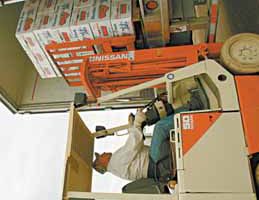| A volunteer helps unload items delivered to the county pantry in Price as part of the Utah Food Bank statewide project. Diverse crowds of Castle Valley residents gather at the food bank to participate in the monthly program. |
Each month, Castle Valley residents start to show up at the Carbon County Food Bank as early as 7 a.m., regardless of the weather. People stand in the parking lot with wagons, wheel barrows, hand trucks and boxes, waiting for the food delivery trucks to arrive in Price.
Two to three hours later ,the truck arrives and volunteers begin to unload the trailer. By that time, the crowd has grown to 150 to 300 people, depending on the time of year and the way things are going economically in Carbon County.
The crowd is diverse. Elderly people are mixed with young families accompanied by small children. All ages appear to be represented in the group.
For many people waiting in line, the items they will receive may be some of the main food stuffs they will have for the month.
For a few people, the items may be all the food they get for the month.
Some of the people are retired, while others are on disability. Many are unemployed, but more are underemployed with part-time low-wage jobs.
“I know one woman who has a pension of $289 per month that she has to live on,” pointed out one food bank volunteer. “How can anyone make it on that much money, paying the heat, light bills and for food. She has to skip her medication most months. She has to make a choice between food and her pharmaceuticals. This food drop helps people like her a lot.”
After the trucks are unloaded, food bank coordinator Dondre Nance instructs the volunteers on what can be given out to each family so there is enough for everyone.
The pallets lining the edge of the parking lot contain a variety of food items, ranging from apples and potatoes to cookies and pies in boxes.
Some food items are loose packed in cases and people have to take a whole case. Other foods come in large containers, like gallon cans of pears. All items came from the Utah Food Bank, not local donations.
After the delivery trucks are unloaded, the crowd starts streaming by the pallets and volunteers help people load the food items into carts, boxes and wagons.
“People don’t often understand that this is a Utah Food Bank project, not a local one,” explained Nance. “We just administer this part.”
When asked what the local pantry does when delivery falls on a bad weather day, the food bank director said the volunteers and recipients take the situation in stride.
“Last month, it was really cold. But it didn’t snow or anything. The crowd was smaller, but we still distributed the food,” noted Nance.
But even with the monthly deliveries from the state food bank project, Nance continues to worry about the situation in the local area.
The seemingly full food bank building can deceptively appear to house an adequate supply when the uninitiated party happens to looks inside the warehouse.
“If you looked in the storage area right now, you would think we have a lot of food there,” pointed out Nance. “What we are doing in this parking lot is a once a month thing, a supplemental thing for most people.”
“What we presently have in the warehouse is almost all USDA food, with very few local contributions. We can only give out one box of the USDA food a month from there to each recipient, no matter their need or how much we have. That’s the rule. If they need more, we have to get it through private donations and food drives. Right now, that well is pretty dry,” continued the Carbon County Food Bank director.
But the situation is not unusual, explained the food bank director.
Between Thanksgiving and Christmas the food bank passed out over 50,000 pounds of donated food to hundreds of local residents.
However, the donations do not arrive in adequate quantities to meet the local demands and needs placed on the food bank during other parts of the year.
“People give and give during the holidays, and we really appreciate that. But we seem to be forgotten the rest of the year. The worst time is the summer; donations go way down. But hunger doesn’t decrease for those in need,” pointed out Nance as she hurried off to handle a problem at the other end of the line.
By that time, people had already passed through and started pushing carts off to unload the food in vehicles.
A few walk off with boxes, carrying the food items. There are no vehicles to put the food in and the people are getting the items home the only way they can.
A few hours later, all of the people had finished going through the line and little is left behind, with the exception discarded plastic wrap, boxes and pallets that need to be returned.
But when the state food bank trucks come back to the Carbon County area next month, the need will still remain clearly evident, in the same degree of demand or greater quantities than before.
Between now and then, the food bank will continue to try to help people in need – the Castle Valley residents who cannot wait until the trailer rolls into town again.

